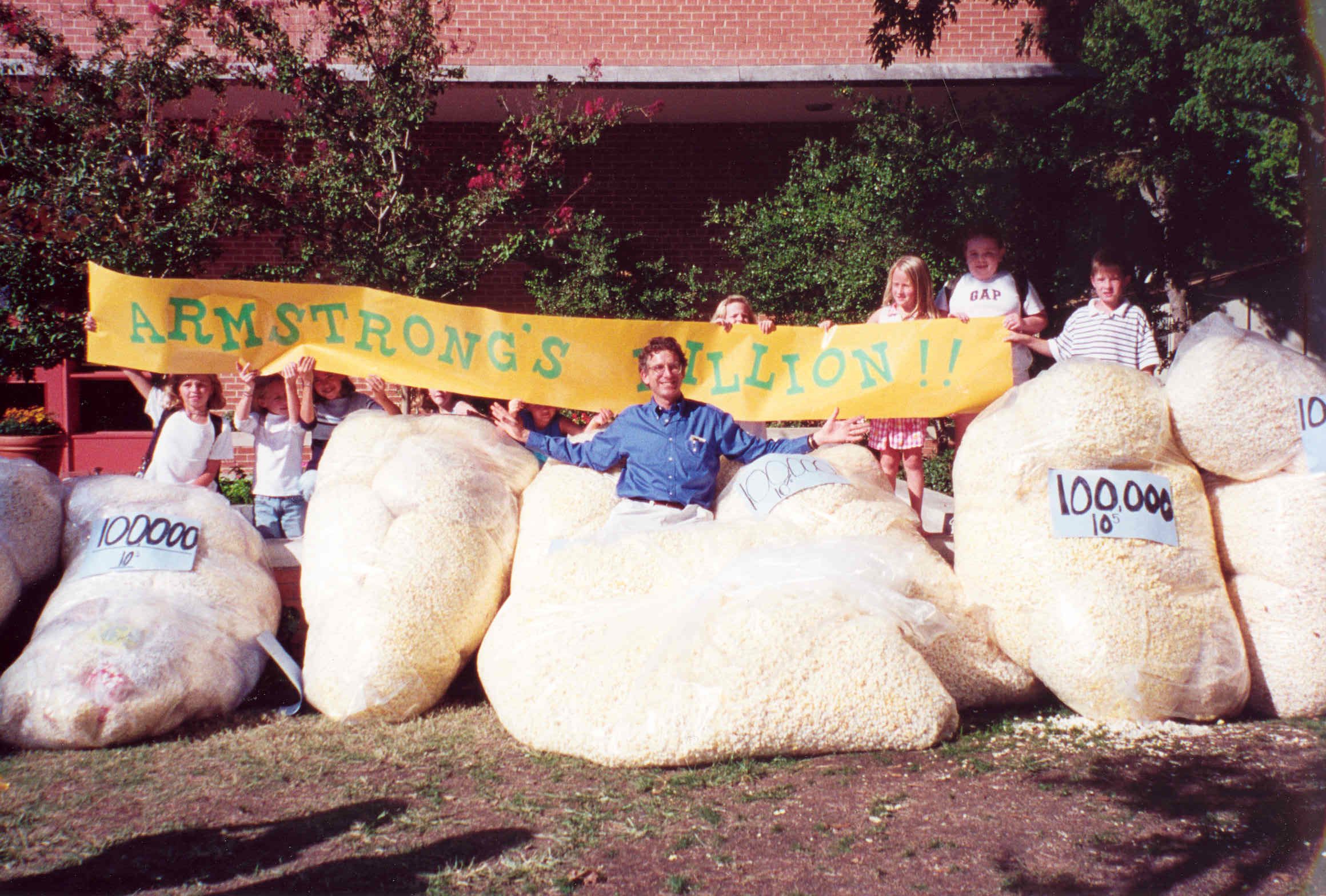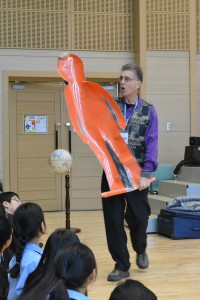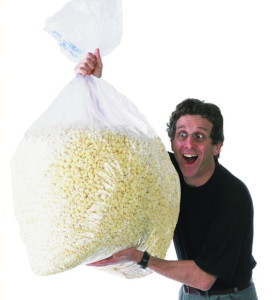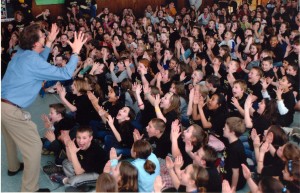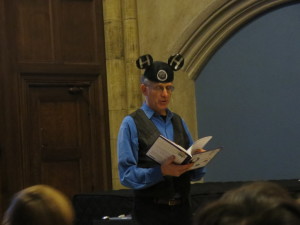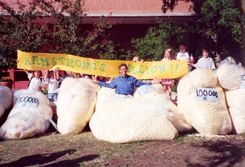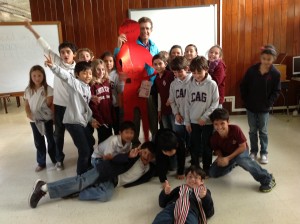Company’s Coming
When food is served, math can be dished up at the same time. Children will be eager to help themselves to both the meal and the math.
Most days, four people dine at the Archibold home, but today company’s coming. There will be five for lunch. The frittata is out of the oven. Soon it will have to be cut by 7-year-old twins Evvy and Mariah.
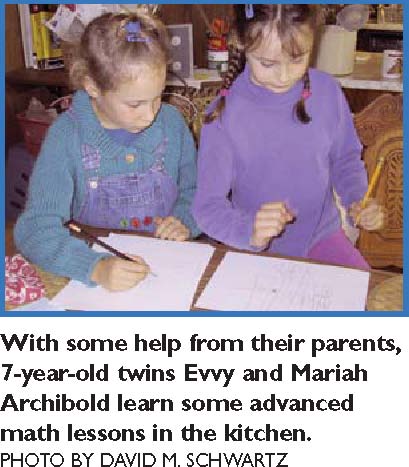 Mom: How many pieces should we make?
Mom: How many pieces should we make?
Evvy: Five.
Mom: Why?
Evvy: There are five people.
Mom: Do you think everyone will eat the same amount?
Mariah: No. Adults eat more.
It is decided that the three adults will each get two pieces while the children will have one. Of course, the girls have to figure out how many pieces are needed all together.
Mariah (after thinking): Eight.
Dad: How do you know?
Mariah: There are three adults, so that’s one-two… three-four… five-six… and the kids have one each, so that’s seven and eight.
Dad: So how can we cut the frittata into eight pieces?
Out come paper and pencils so they can draw up their plans for dividing the frittata into “eighths” (a term adults can use without explanation, since it is obvious from context). Several division schemes are considered before the idea of two rows and four columns emerges as the winner. But another possibility is suggested:
Mom: Suppose we wanted 12 pieces. How would you divide the pan?
Soon the girls are inventing their own scenarios and solving them without prompting. Thinking ahead, Mom shows Evvy and Mariah the cake they will have for dessert. She complicates the problem in a new way.
Mom: Let’s eat half of it today and save the rest for tomorrow. How should we cut it?
Even something as simple as setting the table can be a math lesson for young ones: Count the number of plates, glasses and cutlery to be carried to the table. How does it change when there are guests? With one knife, one spoon, one fork and so forth for each setting, the young tablesetter is dealing with the basic math concept of matching, or “one-to-one correspondence.”
When Evvy and Mariah had to divvy up the frittata so that the three adults each got two and the two children each got one, they were actually being exposed to algebra! A middle-school math teacher might have expressed it more abstractly, but by the time these girls enter middle school, they will easily be able to understand the frittata problem as an algebraic equation.
When they tried out different combinations of rows and columns, they were learning not only about area and geometry, but basic multiplication visualized in a grid. Their parents did not proclaim “Right!” or “Wrong!,” but instead asked the children to justify their thinking, a strategy that helps kids think clearly about whether their answers make sense.
In the few minutes before lunch, Evvy and Mariah solved real life, real food problems with math. What could be tastier? Math Moments are an appropriate side dish to any meal.
Math Moments™ creator David Schwartz spends much of his time finding unusual, whimsical ways to make math and science come alive for kids and teachers, both through writing and through speaking at schools and conferences. He has written nearly 50 books for kids, including How Much Is a Million? and the “Look Once, Look Again” series.
Share Your Math Moments
David Schwartz would love to include your family’s Math Moments in this column. Send your stories and photos, along with your name and mailing address. David will award a signed copy of one of his books to those whose submissions he uses in this column.
Driven by Math
Every morning, Michael Pease drives his daughters to school. It’s a seven-minute drive and Michael makes sure the minutes are used well by playing mental math games with Maddy, 7, and Jessie, 11.
“Who wants a head problem?” he asks, turning out of the driveway. Both girls shout,“I do!” He starts with Maddy.
 “Take the number of sides of a hexagon… double it… take two from that… take half of that. What do you get?”
“Take the number of sides of a hexagon… double it… take two from that… take half of that. What do you get?”
“Five,” blurts out Maddy.
“Give me five!” he says, extending a hand over his shoulder to the backseat. Now it’s Jessie’s turn. She’s older, so the math gets harder.
“Take the number of people in the car (three)… Raise it to the fourth power… Add the digits…Take the square root… Multiply by 13. What do you get?” Jessie pauses about two seconds.
“Thirty-nine!”
Michael believes that turning mental math into an enjoyable daily game helps both girls excel in math. “My goal is to help them feel confident and successful,” he explains, “and to see math as fun, useful and meaningful.”
Any family can invent games that transform car trips into math-rich experiences. The Pease girls came up with “Target Number.” They pick a number (like 100) and then add and subtract the numbers they find on road signs until one player hits the target exactly.
Beth Hook’s family gets mileage out of the rising price of gas. “On our drive to school, my kids and I write down the price,” says Beth. “The next day, we find out how much it has gone up. Next week, we’ll figure out the seven-day rise.” To do the math, Beth taught her children some mental math techniques. When gas cost $1.99 per gallon, you have to “count on” by one cent to get to $2. When it rose to $2.07 per gallon, it was 7 cents above $2. To get the total price increase, just add 1 plus 7.
Easy! Taking it another step, a parent might ask, “If the price keeps rising this fast, what will it be a year from now?” Banish the thought!
Howie and Marcy Black have turned “Twenty Questions” into a family math game. “Who has a number between one and 100?”
“I do,” comes a voice from the backseat.
“Is it less than 50?” asks another child.
“Yes.”
“Is it odd?”
Yes.
“A prime number?”
“A what?” asks 7-year-old Tania. Her older brother, Paul, explains that a prime number is divisible only by one and itself.
“No.”
“Is it divisible by three?”
And so on. The kids are entertained, they are learning math… and they get to their destination without once asking “Are we there yet?”
Math Moments™ creator David Schwartz spends much of his time finding unusual, whimsical ways to make math and science come alive for kids and teachers, both through writing and through speaking at schools and conferences. He has written nearly 50 books for kids, including How Much Is a Million? and the “Look Once, Look Again” series.
Share Your Math Moments
David Schwartz would love to include your family’s Math Moments in this column. Send your stories and photos, along with your name and mailing address. David will award a signed copy of one of his books to those whose submissions he uses in this column.
Big Lesson from Big Numbers
Susan Jarema doesn’t have to look far to find Math Moments. Her two children, Maya, 6, and Colin, 4, provide them on a daily basis with their imaginative questions: “How many slugs are in Canada?” “How many stars are in the universe?” “How many termites are in a termite hill?” “How many bacteria are inside me when I’m sick?”
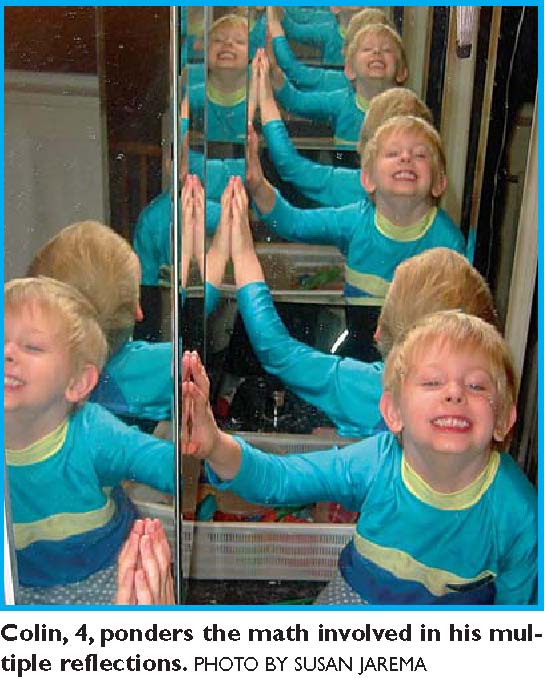 Moments before bedtime one evening, Colin wonders how many seconds he has lived. Susan can’t resist pulling out a calculator to answer the question: More than 100 million seconds! Not to be outdone in bedtime extensions, Maya suggests this scenario: “If we had 27 kids and they each fought with each other once, how many fights would that be?”
Moments before bedtime one evening, Colin wonders how many seconds he has lived. Susan can’t resist pulling out a calculator to answer the question: More than 100 million seconds! Not to be outdone in bedtime extensions, Maya suggests this scenario: “If we had 27 kids and they each fought with each other once, how many fights would that be?”
Numbers like million, billion, trillion and googol (a one with a hundred zeros) are fascinating to children of all ages. Parents can draw upon them to help kids understand the basis of our number system: each additional zero multiplies the value 10 times.
Here’s one way to get a handle on big numbers:
- Look for a thousand of some common object (blades of grass, for instance, or tufts of carpeting).
- Write the numeral 1,000.
- Now imagine a thousand of these thousands (1,000 X 1,000) to get a million:1,000,000. A thousand million (1,000 X 1,000,000) is a billion: 1,000,000,000. A thousand billion (1,000 X 1,000,000,000) is a trillion: 1,000,000,000,000. Don’t be surprised if your child wants to know how many grains of sand are in the world! (One answer: not as many as stars in the universe!)
It is helpful to have “benchmarks” that make large numbers concrete. One family has discovered a thousand bricks in their patio; 10,000 seats in their section of a baseball stadium; 100,000 people living in their suburb. For one million, they taped a large piece of graph paper with 1,000,000 tiny squares onto a wall of their garage.They now have a way to visualize big numbers that often appear in books, newspapers, TV, radio – or in everyday conversation.
Inevitably, children will wonder about infinity. It’s not a number because it doesn’t represent a particular amount, but it is a mathematical concept that stretch es the imagination. In his parents’ bathroom, Colin notices that two mirrors placed in front of each other create a pattern of reflections that seems infinite because “it goes on forever and ever and ever and ever…” Luckily for Susan, on this evening he doesn’t try for infinite bedtime extensions.
Instead, he kisses her goodnight and sweetly says,“Mom, I’ll love you ’til infinity.”
Math Moments™ creator David Schwartz spends much of his time finding unusual, whimsical ways to make math and science come alive for kids and teachers, both through writing and through speaking at schools and conferences. He has written nearly 50 books for kids, including How Much Is a Million? and the “Look Once, Look Again” series.
Share Your Math Moments
David Schwartz would love to include your family’s Math Moments in this column. Send your stories and photos, along with your name and mailing address. David will award a signed copy of one of his books to those whose submissions he uses in this column.
A Fair Day for Math
“How much does it weigh?”
“I have no idea!”
“How much do you think it weighs?”
 Nine-year-old Brien cannot believe his mom is asking him the weight of a cow at the county fair. But Chris Nugent knows a Math Moment when she sees one. She doesn’t expect her son to know the cow’s weight, but she knows he can use some math to come up with a reasonable estimate. Finally, he compares the cow to his mother and decides that the cow weighs five times as much as she does. Being compared to a cow might not flatter his mom, but Chris likes Brien’s approach to the problem. He announces the cow’s weight.
Nine-year-old Brien cannot believe his mom is asking him the weight of a cow at the county fair. But Chris Nugent knows a Math Moment when she sees one. She doesn’t expect her son to know the cow’s weight, but she knows he can use some math to come up with a reasonable estimate. Finally, he compares the cow to his mother and decides that the cow weighs five times as much as she does. Being compared to a cow might not flatter his mom, but Chris likes Brien’s approach to the problem. He announces the cow’s weight.
He’s way off. The cow’s owner tells him that the Holstein weighs about 1,500 pounds – much more than five of Brien’s mom, as she quickly points out.
Brien does better with the pigs. Guessing that six would weigh the same as the cow, he predicts 250 pounds per pig.
“Close, young fella, close!” says the farmer, enjoying the game.
Across the nation, millions of people converge on county and state fairs every summer to see farm products, crafts, games and stage shows. With a little prompting from parents, children can include math in the mix. Carnivals and theme parks don’t have prize pigs, but they offer similar opportunities for mathematical amusement. Waiting with his tray at the cafeteria, Brien starts folding a napkin and Chris points out that he has folded it into eight equal parts. What is each part called? Brien knows they are eighths. His mom asks him what to call four of those eighths? Then she takes another napkin and folds it into fourths. How many of Brien’s eighths equal one of Chris’s fourths? What would he call the portion of the napkin with one fourth and one eighth? Enough fractions for now, it’s burger time! Later, a ride on the Ferris wheel raises the question of how many people the wheel holds. Brien realizes it’s a multiplication problem. He must multiply the number of cars (16) by the number of people in each car (6). Chris shows him how to make easy work of it: 16 is 10 plus 6, so he can multiply each of those numbers by six and add the results.“Sixty,” Brien says tentatively, “plus 36… is 96. Easy!”
Now Brien is getting into the spirit of his mom’s mathematical mentoring. “How many screws are in the roller coaster?” he wonders aloud. But neither of them stops to figure it out as they rush to the Big Top to catch a magician’s act. By the time they head to their car in the parking lot, Brien and Chris are bushed, but Math Moments keep cropping up. “If we count the cars in this row as we walk by, and multiply by the number of rows…”
Math Moments™ creator David Schwartz spends much of his time finding unusual, whimsical ways to make math and science come alive for kids and teachers, both through writing and through speaking at schools and conferences. He has written nearly 50 books for kids, including How Much Is a Million? and the “Look Once, Look Again” series.
Share Your Math Moments
David Schwartz would love to include your family’s Math Moments in this column. Send your stories and photos, along with your name and mailing address. David will award a signed copy of one of his books to those whose submissions he uses in this column.
